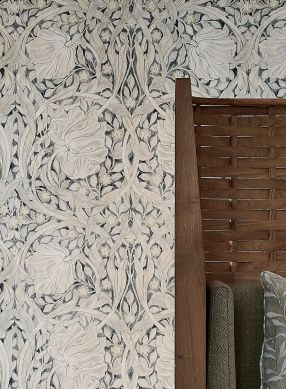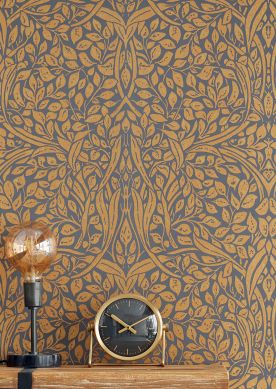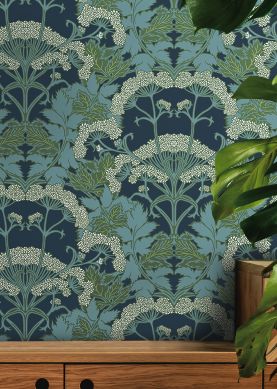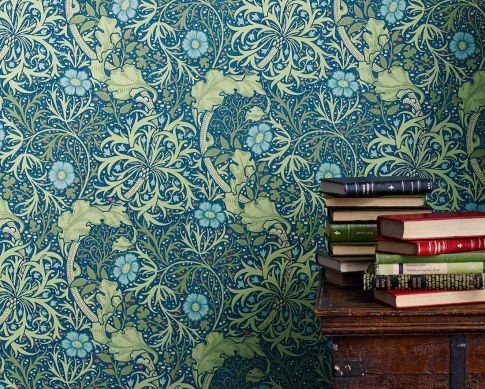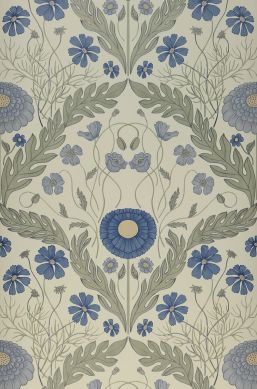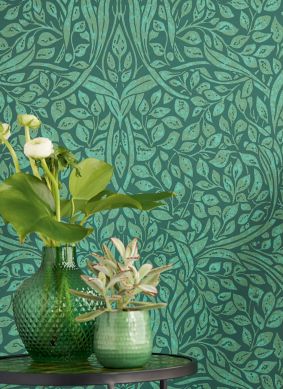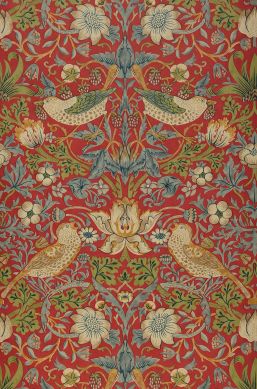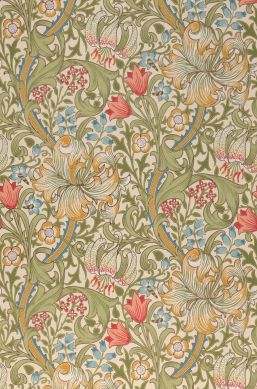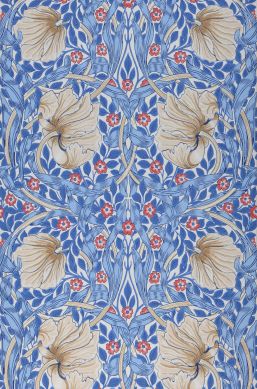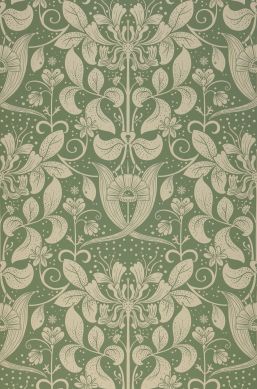Art Nouveau Wallpaper
Art Nouveau Wallpaper: The Guide
The decorative art of the turn of the last century (around 1890 to 1910) was considered a movement of renewal, but at the same time it relied on traditional craftsmanship instead of industrial mass production. Today, it is interpreted in classic or innovative ways by wallpaper designers from all over the world. The style is based on nature with all its beautiful organic forms, and the rich imagination and stunning works of great Art Nouveau icons such as Gustav Klimt or Antoni Gaudí serve as rich inspiration for today's Art Nouveau wallpaper models.
Table of Contents
- What are wallpaper patterns in the Art Nouveau style?
- What are the geographical characteristics and special features of Art Nouveau?
- What are the special characteristics of Art Nouveau wallpaper patterns?
- Which rooms are wallpapers of the Art Nouveau era most suitable for?
- What are the most popular colours for Art Nouveau wallpaper?
- Which artists serve as inspiration for Art Nouveau wallpaper?
- Which wallpaper brands are specialised in Art Nouveau patterns?
- Our tips: Ideas for design projects with Art Nouveau wallpaper
What are wallpaper patterns in the Art Nouveau style?
"Art Nouveau" is the term used to describe an epoch of art history at the turn of the 19th to the 20th century which brought art back into everyday life. The style is inspired by nature and characterised by a sense of lightness and elegance.
An era of art history
Art Nouveau is a period of art history which enjoyed its initial heyday between 1890 and 1910. The young, modern and original movement rejected historicism and also opposed the drive towards soulless industrialisation with its mass character. It identified as a revolt against conservative obsessions and the conventional language of forms.
Reintegration of art into everyday life
Art Nouveau was preceded by the British Arts & Crafts movement which - unsurprisingly - combines art and traditional crafts. One of the most important representatives of this movement was William Morris. Art which stands out for its inherent functionality: the concept of Art Nouveau is that of a functional yet decorative component in all areas of everyday life.
Nature as source of inspiration and stylistic device
For painting and graphic art, nature is the inspiration, represented by large, often stylised, floral ornaments. Shapes are organic and varied, tempting us to pause and dream for a moment. This creates a strong and deliberate contrast to the rapid development of industrialisation with its uniformity and mass-compatibility.
Lightness and elegance
A light playfulness and enchanting elegance characterise the pattern motifs of Art Nouveau, which pays homage to art with a special love of detail. Just as youth moves with a light foot, a light heart and with great zest for action, this concise style develops into a form of expression for a new generation that is neither too tied to the past nor wanting to rush into the future.
What are the geographical characteristics and special features of Art Nouveau?
Depending on specific countries, there are different trends and terms for this extraordinary style era. Among the most important European-national characteristics are Art Nouveau, Jugendstil, Secession style, Modernisme, Liberty and Modern Style.
Jugendstil
Named after the magazine "Jugend", founded in Munich in 1895, Jugendstil (the style of the youth) developed under this name in Germany, the Netherlands, Scandinavia and the Baltic States. Art and life merge into one. Everyday objects are redesigned with a decorative factor in mind.
Art Nouveau
In France and Belgium, Art Nouveau is considerer a new approach to life, but also as a renewal of spirit and mind. It was founded by gallery owner Samuel Bing who was famous for the design of functional utility objects influenced by, amongst other concepts, Asian art and fashion. Asymmetrical complexity and playful lines are the hallmarks of this artistic movement.
Secession style
Secession style or Viennese Art Nouveau is the name of the modern art movement in Austria/Hungary and other Eastern European countries. The Viennese Secession is an association of artists, including Gustav Klimt, who consciously distance themselves from Historicism. Viennese Art Nouveau incorporates a sense of decadence and is characterised by Freud's psychoanalysis and a new, liberal self-image.
Catalan modernism
In Catalonia, especially in Barcelona, Modernisme developed as a movement of renewal in the cultural and social field. Impressionism and Symbolism had a huge influence on the art form of painting. In architecture and design, Antoni Gaudí set new standards with his naturally dynamic language of forms.
Floreale/Liberty styles
At the beginning of the 20th century, the Floreale or Liberty style became popular in Italy. The new Liberty style allows Arabic and northern influences to flow into decorative design. In terms of architecture, this manifests in domes and turrets with floral patterns. Craftsmanship and art are a unity that creates sophisticated designs.
Modern Style
The Modern Style in Great Britain is strongly influenced by the Arts and Crafts movement. Much of it is based on Pre-Raphaelism and the Gothic era, but Japanese art motifs as well as artisan handicrafts are also popular components of the Modern Style.
What are the special characteristics of Art Nouveau wallpaper patterns?
Art Nouveau patterns draw on motifs from nature with a generous dose of imagination and humour. Flowers, blossoms, floral ornaments, tendrils as well as symbolic creatures in animal form play the main roles in Art Nouveau wallpaper designs.
Flowers and blossoms
Flowers & blossoms are among the favourite pattern motifs in Art Nouveau. Their slender, tall silhouette is often depicted in the shape of a chalice (e.g. tulips) or a trumpet. Although the recognition value is usually very high, flowers often have an imaginative and new effect due to curved or intertwined lines.
Floral ornaments
In Art Nouveau, ornaments consisting of blossoms, flower heads, leaves or plant components often appear abstract and seemingly infinite. The labyrinth of ramifications and stylistic subtleties is pleasing to the eye. They can also be embedded in perfect geometry. Strong contrasting colours increase the decorative factor.
Leaves and tendrils
Leaves and tendrils can be decorative accessories in an opulent design, but they are also effective on their own. Their clear contours and cool curves are what makes them so striking. The design can be based on arabesques, with their organic, occasionally asymmetrical form placed in rectangular frames.
Symbolic creatures in animal form
Animals such as the peacock and the swan symbolise extravagance and elegant beauty, making them popular motifs in Art Nouveau. Along with many other mythical creatures, they convey subtle messages. Fish and insects (e.g. dragonflies) are also of characteristic importance. The metamorphosis is reflected via chimeras, that is to say creatures that are half human, half animal.
Flowing, curved lines and waves
Like nature with its organic forms which are always in motion, Art Nouveau wallpaper designs feature curved, elongated lines, waves and arches based on geometric shapes. They come in the shape of floral and planar ornaments or as part of the motif (e.g. swan neck). The graphic elements support soft symmetries.
Which rooms are wallpapers of the Art Nouveau era most suitable for?
Art Nouveau wallpaper gives living rooms, bedrooms and bathrooms a sensual, elegant touch. In restaurants, it can help create an upscale, intimate atmosphere that encourages the enjoyment of food.
Living room
Elaborate floral ornaments following a geometric, asymmetrical or symmetrical line and motifs with peacocks and other mythical creatures attract the eye. Furniture and furnishings should match the style and colours of the wallpaper. Bright colours require a calm environment.
Bedroom
In the bedroom, Art Nouveau patterns serve the demand for privacy. Whether to choose dark or light wallpaper colours is a question of the mood that is to be created and depends on the room layout.
Bathroom
Wallpaper with Art Nouveau pattern motifs in dark, intense colours, perhaps with a bit of gold for a touch of luxury, are perfectly suited to the bathroom. This room dedicated to privacy and beauty has huge potential for decorative art concepts.
Restaurants
In the Art Nouveau era, artists and craftsmen gathered in authentically designed restaurants or bars to exchange ideas. Art Nouveau wallpaper provides a creative, communicative atmosphere with a generous dose of cosiness.
What are the most popular colours for Art Nouveau wallpaper?
There is almost no colour that doesn't work with the Art Nouveau style. Wallpaper colour favourites include blue, green, gold, silver, grey and red.
Blue
Blue symbolises harmony, sympathy, infinity, it represents water and the sky. Medium shades of grey-blue, steel blue or light blue are all popular nuances. On Art Nouveau wallpaper models, the luxury aspect is often expressed with royal blue and ultramarine blue.
Green
Green is a popular colour for Art Nouveau wallpaper as it is associated with nature. Mixed shades of green in lighter and darker tones play a major role, with green usually being supplemented by other bright colours to bring out details.
Gold
Gustav Klimt developed gold into a sophisticated complementary Art Nouveau colour. Gold adds a touch of refinement to specific elements, and as a background shade, the colour of the sun brings the motif into the foreground.
Silver
In Art Nouveau, silver is not the opposite of gold - au contraire! The colour of lightness and freedom can emphasise and complement gold. In combination with other colours, it exudes a subtle luxury and represents the shine of enchanting ice crystals.
Grey
Grey stands for modernity and, at the same time, it's a neutral colour that can be combined with almost all others. In combination with white, black and silver, grey appears very elegant and artistic, which is perfect for Art Nouveau wallpapers.
Red
Red is often chosen as the basic or pattern colour for Art Nouveau wallpaper to deliberately attract attention. The colour of passion is a powerful intensifier for the craftsmanship implied in elaborate structures and textures.
Which artists serve as inspiration for Art Nouveau wallpaper?
The works and creations of famous artists of the Art Nouveau era are often used as models for new wallpaper creations. Emile Gallé, Gustav Klimt, Antoni Gaudí and Louis C. Tiffany are a representative cross-section of the style icons of Art Nouveau.
Emile Gallé
The most important representative of Art Nouveau is Emile Gallé (1846-1904), whose glass art and faiences were in international demand during the Art Nouveau period. His glass cameos are world-famous, and he is also considered the inventor of inlay work in glass. Until the 1930s, Art Nouveau-style production was carried out in French workshops for glass, ceramics and wood.
Gustav Klimt
Austrian artist Gustav Klimt (1862-1918) went down in art history as the founding president of the Vienna Secession and master of the new language of art. With his portraits, allegories and landscapes, he influenced Viennese Art Nouveau like no other. Klimt was an advocate of colour, and gold in particular became his trademark.
Antoni Gaudí
Spanish architect Antoni Gaudí (1852-1926) is considered one of the most important representatives of the Catalan Modernisme. Organic, surrealistic forms, inspired by flora and fauna as well as Gothic elements, are as typical for Gaudí's buildings as are colourful ceramic tiles. Under his guidance, blacksmithing, mosaics, glass art and carpentry were given a fantastic new platform.
Louis C. Tiffany
Tiffany is the epitome of the excellent glass art and jewellery creations of the same name. The inspiration behind it is the American entrepreneur, painter and glass designer Louis C. Tiffany (1848-1933), one of the most important representatives of American Art Nouveau. Tiffany glass creations with enchanting floral designs represent Art Nouveau art worldwide.
Which wallpaper brands are specialised in Art Nouveau patterns?
Art Nouveau wallpaper patterns require a high degree of experience and talent as well as the courage to be innovative from designers and manufacturers alike. Anaglypta, Cole & Son and Morris & Co. are three of the most famous contemporary wallpaper brands providing Art Nouveau wallpaper models.
Anaglypta
In 1887, Englishman Thomas Palmer developed and patented an embossed wallpaper type called Anaglypta which was a revolutionary alternative to the so-called Lincrusta wall covering at the time. At the turn of the century, the environmentally friendly embossed and paintable wallpaper had already conquered the market. In contrast to many foamed relief wallpaper types of those days, Anaglypta sticks to its tradition of dispensing with chemical components such as plastics to this day.
Cole & Son
Since 1873, Cole & Son, based in London, has been producing classic wallpaper designs produced with traditional printing techniques to decorate rooms in world-famous buildings such as Buckingham Palace and the White House. The British wallpaper manufacturer is known for immensely successful collaborations with artists resulting in unique creations, including Art Nouveau wallpapers.
Morris & Co.
William Morris was the most important figurehead of the British Arts and Crafts movement (which included Art Nouveau designs). In 1861, he founded Morris, Marshall, Faulkner & Co. (today Morris & Co.), a design manufactory for fabrics and wallpapers. Today, its focus is on handmade products. The wallpaper patterns are inspired by (or are reprints of) the in-house archive.
Our tips: Ideas for design projects with Art Nouveau wallpaper
- Art Nouveau meets Tulip design in the dining room: A symmetrical, large-format Art Nouveau pattern in black and white or red and white beautifully sets the scene for a stylish 1960s Tulip table and four Tulip chairs. This ingenious break in style creates an eye-catching contrast.
- Art Nouveau mirror wall in the bathroom: Choose an Art Nouveau pattern wallpaper and use it to beautify the wall behind the washbasin. Add a stylish mirror and Tiffany lamps. Unless you use highly washable vinyl wallpaper, the splash zone should be sealed with suitable products to make it water-repellent.
- XXL Art Nouveau painting: Have a plywood panel cut to size, e.g. 1.20 x 1.80 m. Now add a beautiful Art Nouveau wallpaper matching the interior design in terms of colour and style. It will look particularly classy if you attach LED strips for indirect lighting at the top and bottom of the panel.
- Chinese wedding cabinet with Art Nouveau décor:
The straight-lined furniture design of a Chinese wedding cabinet is perfect for decorating the doors and drawers with a fantastic floral Art Nouveau pattern. Shelf, sides and rear panel are painted in matching colours or remain untreated (wood).




